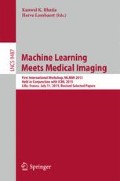Abstract
Modelling longitudinal changes in organs is fundamental for the understanding of biological and pathological processes. Most of the previous works on spatio-temporal modelling of image time series relies on the assumption of stationarity of the local spatial correlation, and on the separability between spatial and temporal processes. These assumptions are often made in order to lead to computationally tractable approaches to longitudinal modelling, but inevitably lead to an oversimplification of the complex spatial and temporal dynamics underlying the biological processes. In this work we propose a novel spatio-temporal generative model of time series of images based on kernel convolutions of a white noise Gaussian process. The proposed model is parameterised by a sparse set of control points independently identified by specific spatial and temporal parameters. This formulation is highly flexible and can naturally account for spatially and temporally varying dynamics of changes. We demonstrate a preliminary application of our non-parametric method on the modelling of within-subject structural changes in the context of longitudinal analysis in Alzheimer’s disease. In particular we show that our method provides an accurate description of the pathological evolution of the brain, while showing high flexibility in modelling and predicting region-specific non-linearity due to accelerated structural decline in dementia.
S. Ourselin—Data used in preparation of this article were obtained from the Alzheimer’s Disease Neuroimaging Initiative (ADNI) database (www.loni.ucla.edu/ADNI). As such, the investigators within the ADNI contributed to the design and implementation of ADNI and/or provided data but did not participate in analysis or writing of this report. A complete listing of ADNI investigators can be found at: www.loni.ucla.edu/ADNI/Collaboration/ADNI_Authorship_list.pdf.
Access this chapter
Tax calculation will be finalised at checkout
Purchases are for personal use only
References
Davis, B.C., Fletcher, P.T., Bullitt, E., Joshi, S.C.: Population shape regression from random design data. Int. J. Comput. Vis. 90(2), 255–266 (2010)
Ashburner, J., Ridgway, G.: Symmetric diffeomorphic modeling of longitudinal structural MRI. Front. Neurosci. 6(197) (2013)
Niethammer, M., Huang, Y., Vialard, F.-X.: Geodesic regression for image time-series. In: Fichtinger, G., Martel, A., Peters, T. (eds.) MICCAI 2011, Part II. LNCS, vol. 6892, pp. 655–662. Springer, Heidelberg (2011)
Lorenzi, M., Ayache, N., Frisoni, G.B., Pennec, X.: Mapping the effects of A\(\beta \) 1–42 levels on the longitudinal changes in healthy aging: hierarchical modeling based on stationary velocity fields. In: Fichtinger, G., Martel, A., Peters, T. (eds.) MICCAI 2011, Part II. LNCS, vol. 6892, pp. 663–670. Springer, Heidelberg (2011)
Friston, K.J., Holmes, A., Worsley, K.J.: Statistical parametric maps in functional imaging: a general linear approach. Hum. Brain Mapp. 2, 189–210 (1995)
Ziegler, G., Ridgway, G.R., Dahnke, R., Gaser, C.: Individualized Gaussian process-based prediction and detection of local and global gray matter abnormalities in elderly subjects. NeuroImage 97, 333–348 (2014)
Rasmussen, C.E., Williams, C.K.I.: Gaussian Processes for Machine Learning. The MIT Press, Cambridge (2005)
Lorenzi, M., Ziegler, G., Alexander, D.C., Ourselin, S.: Efficient Gaussian process-based modelling and prediction of image time series. In: Ourselin, S., Alexander, D.C., Westin, C.-F., Cardoso, M.J. (eds.) IPMI 2015. LNCS, vol. 9123, pp. 626–637. Springer, Heidelberg (2015)
Higdon, D.: Space and space-time modeling using process convolutions. In: Anderson, C.W., Barnett, V., Chatwin, P.C., El-Shaarawi, A.H. (eds.) Quantitative Methods for Current Environmental Issues, pp. 37–56. Springer, London (2002)
Ashburner, J., Friston, K.: Unified segmentation. NeuroImage 26, 839–851 (2005)
DiMatteo, I., Genovese, C.: Bayesian curve-fitting with free-knot splines. Biometrika 88, 1055–1071 (2002)
Paciorek, C., Schervish, M.: Nonstationary covariance functions for Gaussian process regression. Adv. Neural Inf. Proc. Sys. 16, 273–280 (2004)
Author information
Authors and Affiliations
Corresponding author
Editor information
Editors and Affiliations
Appendix
Appendix
We explicit here the derivatives of the log-marginal likelihood (5) with respect to the model parameters \(\varvec{\theta }\):
With the following simplification
the derivative are as follows:
-
Noise parameter.
$$\begin{aligned} \frac{\mathrm {d}}{\mathrm {d}\sigma _{\epsilon }^2}\log \mathcal {L}&= \frac{1}{2} [- N + \frac{1}{\sigma _{\epsilon }^2} Tr(K^T K A) \end{aligned}$$(15)$$\begin{aligned}&\quad \,+ y^T \left( \frac{1}{\sigma _{\epsilon }^2} Id_{N} - \frac{2}{\sigma _{\epsilon }^4} K A K^T + \frac{1}{\sigma _{\epsilon }^6} K A K^T K A K^T \right) y ]. \end{aligned}$$(16) -
Amplitude parameter.
$$\begin{aligned} \frac{\mathrm {d}}{\mathrm {d}\sigma _x^2}\log \mathcal {L}&= -\frac{1}{2} Tr(\frac{\sigma _{\epsilon }^2}{\sigma _x^2} K^T K) - Tr(\frac{\sigma _x^2}{\sigma _{\epsilon }^4} K^T K A K^T K) \end{aligned}$$(17)$$\begin{aligned}&\quad \,+ \!\frac{\sigma _x^2}{2} \left( \frac{1}{\sigma _{\epsilon }^2} y^T K - \frac{1}{\sigma _{\epsilon }^4}y^T K A K^T K \!\right) \left( \frac{1}{\sigma _{\epsilon }^2} K^T y - \frac{1}{\sigma _{\epsilon }^4} K^T K A K^T y \right) \end{aligned}$$(18) -
Control points parameters.
$$\begin{aligned} \frac{\mathrm {d}}{\mathrm {d}\mathcal {\theta }_j}\log \mathcal {L}&= -\frac{\sigma _x^2}{\sigma _{\epsilon }^2} Tr(\frac{\mathrm {d}K}{\mathrm {d}\mathcal {\theta }_j} K^T) + \frac{\sigma _x^2}{\sigma _{\epsilon }^4} Tr( K^T K A K^T \frac{\mathrm {d}K}{\mathrm {d}\mathcal {\theta }_j}) \end{aligned}$$(19)$$\begin{aligned}&\quad \, -2 \frac{\sigma _x^2}{\sigma _{\epsilon }^4} (y^T K \frac{\mathrm {d}K}{\mathrm {d}\mathcal {\theta }_j} y )\end{aligned}$$(20)$$\begin{aligned}&\quad \, +2 \frac{\sigma _x^2}{\sigma _{\epsilon }^6} ( y^T K A K^T \frac{\mathrm {d}K}{\mathrm {d}\mathcal {\theta }_j} K^T y + y^T K A K^T K \frac{\mathrm {d}K}{\mathrm {d}\mathcal {\theta }_j} y )\end{aligned}$$(21)$$\begin{aligned}&\quad \, -2 \frac{\sigma _x^2}{\sigma _{\epsilon }^8} (y^T K A K^T \frac{\mathrm {d}K}{\mathrm {d}\mathcal {\theta }_j} K^T K A K^T y ). \end{aligned}$$(22)
Rights and permissions
Copyright information
© 2015 Springer International Publishing Switzerland
About this paper
Cite this paper
Marco, L., Ziegler, G., Alexander, D.C., Ourselin, S. (2015). Modelling Non-stationary and Non-separable Spatio-Temporal Changes in Neurodegeneration via Gaussian Process Convolution. In: Bhatia, K., Lombaert, H. (eds) Machine Learning Meets Medical Imaging. MLMMI 2015. Lecture Notes in Computer Science(), vol 9487. Springer, Cham. https://doi.org/10.1007/978-3-319-27929-9_4
Download citation
DOI: https://doi.org/10.1007/978-3-319-27929-9_4
Published:
Publisher Name: Springer, Cham
Print ISBN: 978-3-319-27928-2
Online ISBN: 978-3-319-27929-9
eBook Packages: Computer ScienceComputer Science (R0)

